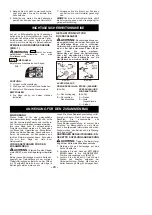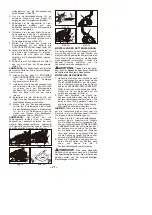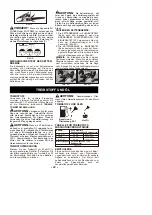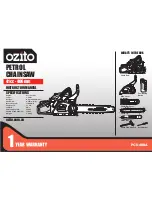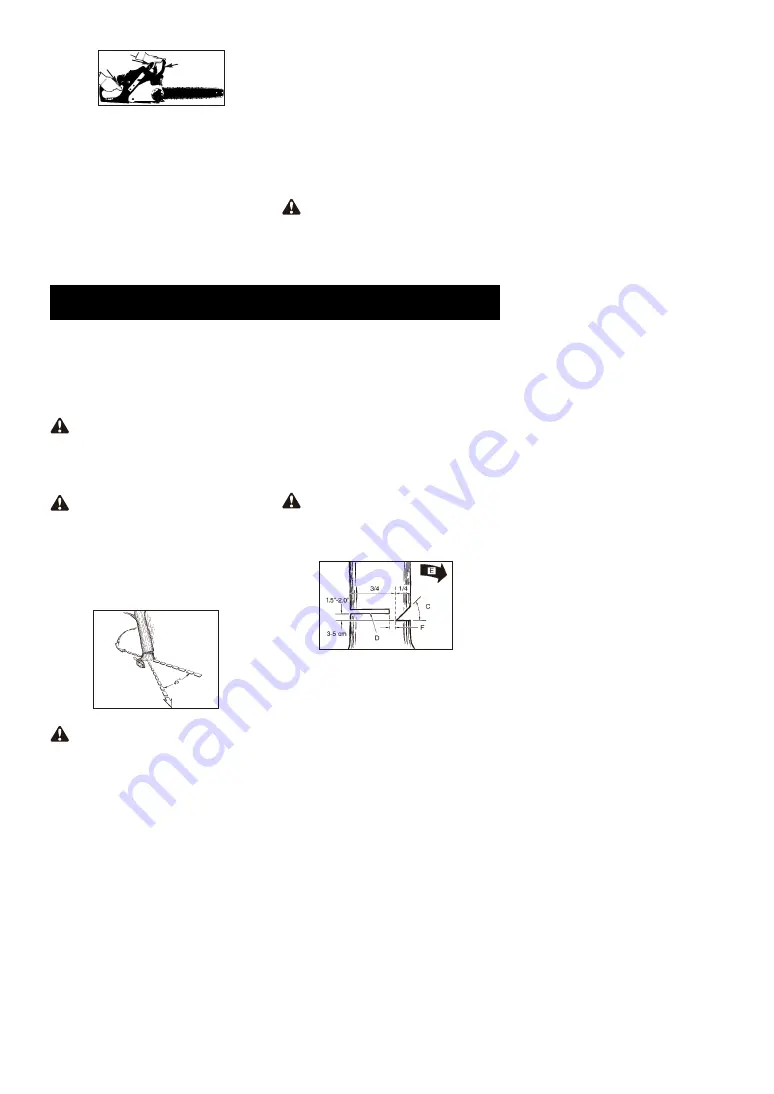
-- 9 --
GENERAL CUTTING INSTRUCTIONS
Adequate lubrication of the saw chain is
essential at all times to minimize friction with
the guide bar.
Never starve the bar and chain of oil.
Running the saw with too little oil will
decrease cutting efficiency, shorten saw
chain life, cause rapid dulling of chain, and
cause excessive wear of bar from
overheating. Too little oil is evidenced by
smoke, bar discoloration or pitch build-up.
NOTE:
Saw chain stretches during use,
particularly when it is new, and it will
Your chain saw is equipped with an
automatic clutch driven oiler system. The
oiler automatically delivers the proper
amount of oil to the bar and chain. As the
engine speed increases, so does the oil flow
to the bar pad. There is no flow adjustment.
The oil reservoir will run out at approximately
the same time as the fuel supply runs out.
WARNING:
Don't put pressure on
the saw when reaching the end of the cut.
The pressure may cause the bar and chain
to rotate. If the rotating chain strikes some
other object, a reactive force may cause
moving chain to strike the operator.
Felling is the term for cutting down a tree.
Small trees up to 6-7 inches (15-18cm) in
diameter are usually cut in a single cut.
Larger trees require notch cuts. Notch cuts
determine the direction the tree will fall.
Normally felling consists of 2 main cutting
operations, notching (C) and making the
felling cut (D).
Start making the upper notch cut (C) on the
side of the tree facing the felling direction
(E). Be sure you don t make the lower cut
too deep into the trunk.
The notch (C) should be deep enough to
create a hinge (F) of sufficient width and
strength. The notch should be wide enough
to direct the fall of the tree for as long as
possible.
NOTE:
Direction of fall (B) is controlled by the
notching cut. Before any cuts are made,
consider the location of larger branches and
natural lean of the tree to determine the way
the tree will fall.
WARNING:
A retreat path (A) should
be planned and cleared as necessary before
cuts are started. The retreat path should
extend back and diagonally to the rear of the
expected line of fall, as illustrated in
Fig.11A.
WARNING:
Never walk in front of a
tree that has been notched.
Make the felling cut (D) from the other side of
the tree and 1.5 - 2.0 inches (3-5 cm) above
the edge of the notch (C) (Fig.11B)
Never saw completely through the trunk.
Always leave a hinge. The hinge guides the
tree. If the trunk is completely cut through,
control over the felling direction is lost.
Insert a wedge or felling lever in the cut well
before the tree becomes unstable and starts
to move. This will prevent the guidebar from
binding in the felling cut if you have
misjudged the falling direction. Make sure no
bystanders have entered the range of the
falling tree before you push it over.
WARNING:
Do not cut down a tree
during high or changing winds or if there is a
danger to property. Consult a tree
professional. Do not cut down a tree if there
is a danger of striking utility wires; notify the
utility company before making any cuts.
CAUTION:
If felling a tree on sloping
ground, the chain saw operator should keep
on the uphill side of the terrain, as the tree is
likely to roll or slide downhill after it is felled.
SAW CHAIN / BAR LUBRICATION
AUTOMATIC OILER
occasionally be necessary to adjust and
tighten it. New chain will require adjustment
after about 5 minutes of operation.
FELLING
FELLING A TREE:
Fig. 11A
B
A
GENERAL GUIDELINES FOR FELLING
TREES:
Fig. 11B
Fig. 10
A
B
C





















